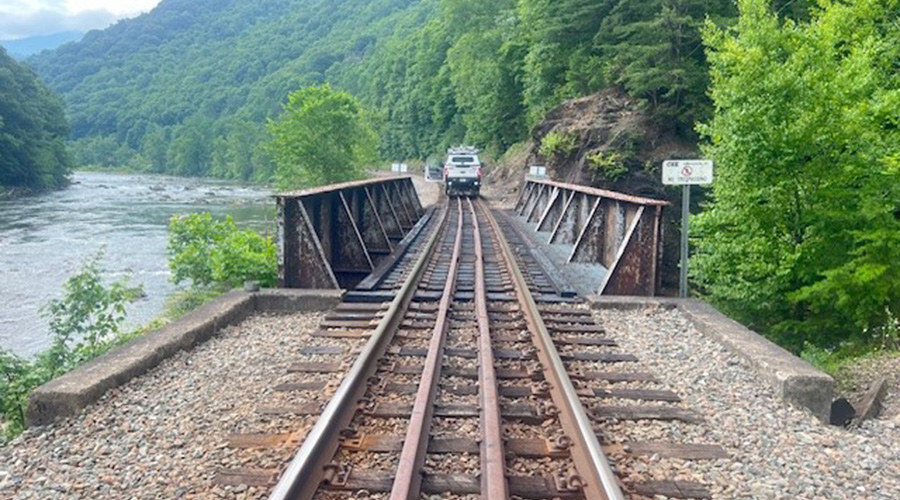Iowa DOT seeks higher crossing safety grade with new six-year action plan
10/13/2022
By Jeff Stagl, Managing Editor
Fourteen years ago, Iowa appeared on a list that was troubling to state transportation leaders: the 10 states with the most grade crossing collisions from 2006 through 2008. Iowa registered between 50 and 100 collisions at some of the state’s 4,094 public and 2,441 private crossings during that period.
As a result, the Rail Safety Improvement Act of 2008 required the 10 states to submit an action plan to the Federal Railroad Administration (FRA) detailing how they expected to improve crossing safety. The Iowa Department of Transportation’s (DOT) Rail Transportation Office then worked in conjunction with Iowa Operation Lifesaver and the 18 railroads operating in the state to craft a 2012-16 Iowa Highway-Rail Grade Crossing Safety Action Plan, which the FRA approved in August 2012.
In 2020, the FRA required the other 40 states to develop crossing safety action plans and the 10 states to update their now six-year-old plans. Iowa now has completed that critical rail safety undertaking.
State transportation officials recently unveiled the 2022-26 Iowa Highway-Rail Grade Crossing Safety Action Plan. In February, the plan was submitted to the FRA, which still is in the process of reviewing it, says Amanda Martin, the Iowa DOT’s rail director.
“We recently posted the plan on our website. The FRA allowed us to do that even though they haven’t officially approved it,” she says, adding that the federal agency hasn’t provided a timetable for final approval and implementation.
The updated plan describes the practices and programs outlined in the originally mandated plan and explains how those initiatives benefited safety or if they were discontinued and why. It also includes new initiatives and action items, and the goals and objectives for implementation.
The 2012-16 plan identified 12 action items to boost crossing safety, of which six remain in the current plan. The 2022-26 plan also includes 10 new action items, bringing the total to 16.
Overall, the new plan aims to reduce crossing risks and set strategies to mitigate risks, comply with new safety requirements, identify crossings with recent or multiple incidents and high-risk crossings, boost prevention of trespassing near crossings and trespasser hotspots, and address crossings with a high number of suicides.
The 16 action items are divided into four categories:
• education, such as school or statewide safety ad campaigns;
• engineering, such as roadway geometry changes or adding rumble strips on paved secondary roads before crossings;
• funding programs and activities, including grade separation opportunities and crossbuck/yield sign renewals; and
• enhanced data collection and analysis, including the development of a crossing accidents map for the state, and the identification of all crossings with humps and dips.
 Through 2022’s first half, Iowa registered 28 collisions at some of the state’s 4,094 public crossings. The accidents resulted in two fatalities. Iowa Department of Transportation
Through 2022’s first half, Iowa registered 28 collisions at some of the state’s 4,094 public crossings. The accidents resulted in two fatalities. Iowa Department of Transportation“The updated safety plan’s action items go beyond the outreach/education-oriented action items of the first plan to include initiatives our rail office will undertake that utilize technology to improve safety,” says Martin. “In addition, the rail office is developing guidance documents for local roadway authorities that will assist with roadway design at crossings to make them inherently safer.”
The plan includes actions requested by the FRA and some that are based on feedback from stakeholders such as Class Is and short lines that provided assistance during the development phase.
“Some actions are more traditional and some are more innovative, such as how we use rumble strips. We are having more discussions on that,” Martin says.
One innovative item is new funding for a crossing elimination program. Only communities can apply for the funds, so a railroad would need to work with a community to seek program dollars, says Martin.
“We think it will be a popular program, so it will be competitive,” she says. “The name of the program doesn't mean a closure is the only option. The program looks at all possibilities of dealing with problematic crossings.”
The new plan also emphasizes a closer examination of trespassing, which isn’t necessarily just occurring at crossings, says Martin. There could be a popular path used to cross from one place to another near tracks.
“We want to see where it’s occurring and what the issues are to prevent trespassing. Awareness is always important,” says Martin.
There currently is no formal program or federal or state funding available for addressing trespasser issues. Components of the new plan are designed to identify instances where federal funding could be leveraged to solve larger problems that are cost prohibitive at the local level, such as large-scale physical barriers to trespassing prevention and grade separations.
Meanwhile, the state also is noting more instances of distracted driving causing some motorists to drive into the side of a train at a crossing. That’s another issue the plan aims to address.
“We are talking to railroads about it since they have their own distracted driving programs,” says Martin.
The new plan soon will take hold after several years of mixed crossing safety statistics. Although collisions at public crossings declined 80.3% in Iowa from 1980 through 2020, the state recorded 25 collisions with no fatalities in 2020 and 40 collisions with six fatalities in 2021. In 2019, there were 47 collisions, which calculates to one collision for every 863,402 vehicles traversing a public crossing.
Through 2022’s first half, Iowa registered 28 collisions at public crossings with two fatalities.
“The purpose of this action plan is to lay a framework for continued reductions of collisions at Iowa’s grade crossings through analysis, discussion and partnerships,” Iowa DOT officials said in the plan’s mission statement.


